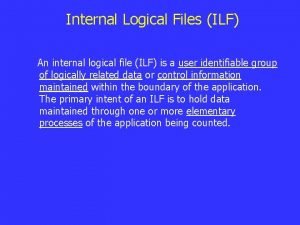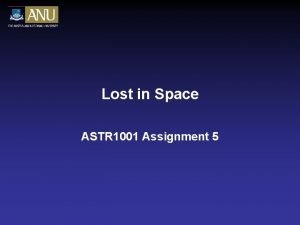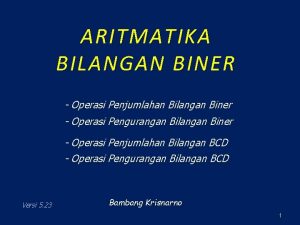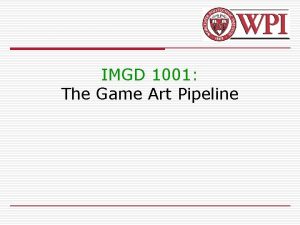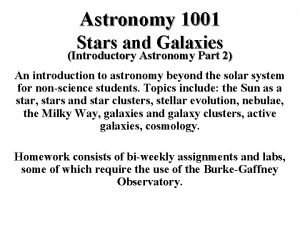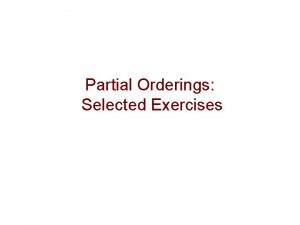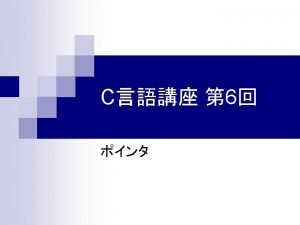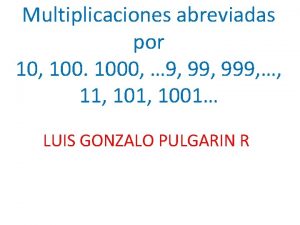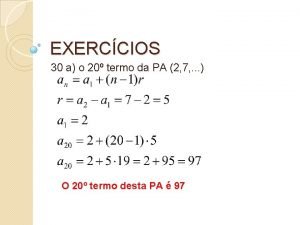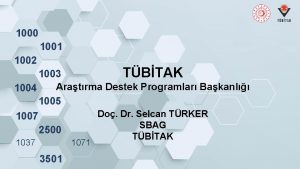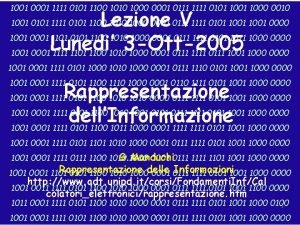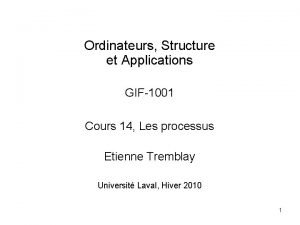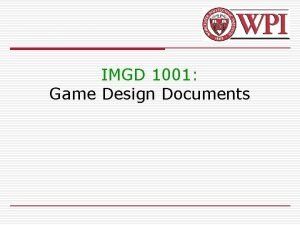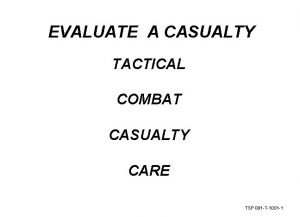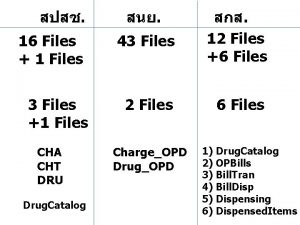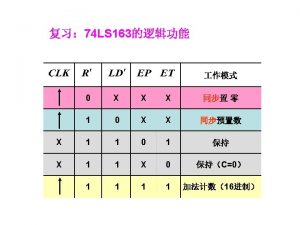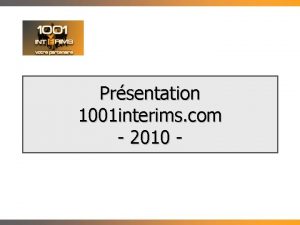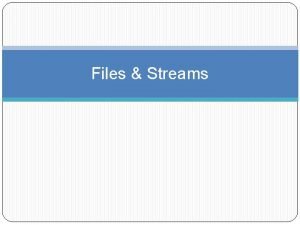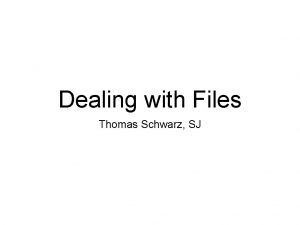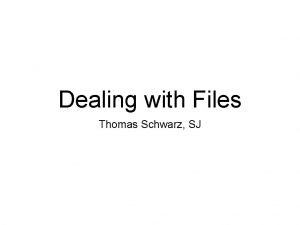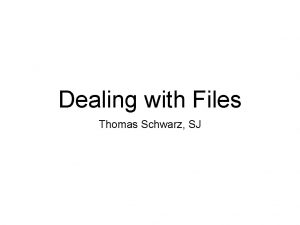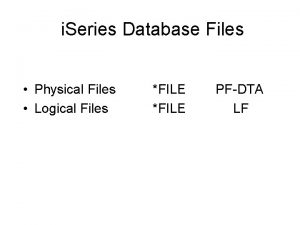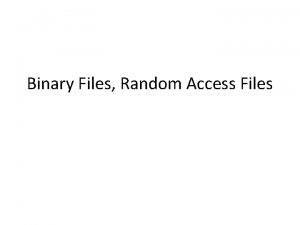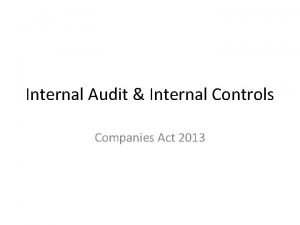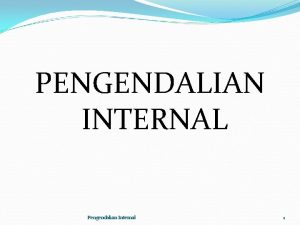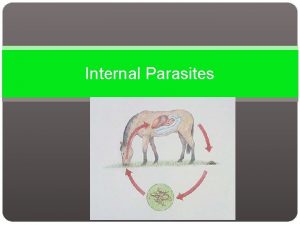CS 1001 Lecture 25 Files Internal Files 27

































- Slides: 33

CS 1001 Lecture 25 • Files • Internal Files 27 April, 2000

File Access • • OPEN the file READ from an existing file WRITE to a new file CLOSE the file 27 April, 2000

OPEN Statement • OPEN (open-list) where open-list is: Must include Unit Specifier Also includes: – FILE = Clause – STATUS = Clause – ACTION = Clause May include – POSITION = Clause – IOSTAT = Clause 27 April, 2000 May include : – ERR = Clause – ACCESS = Clause – FORM = Clause – RECL = Clause – BLANK = Clause – PAD = Clause – DELIM = Clause

Unit Specifier • Required – May not be 0, 5, or 6 – 0 is standard error output, mapped to unit 6 – 5 is standard input, your keyboard – 6 is standard output, your monitor – Has the form UNIT = integer-expression or simply integer-expression FILE = Clause • FILE = character-expression, where characterexpression is the filename e. g. , FILE = “file. out” 27 April, 2000

STATUS = Clause • STATUS = character-expression, where characterexpression can have one of the following values: – – OLD meaning the file already exists NEW meaning the file is being created REPLACE creates a new file to replace an old file SCRATCH no name for FILE= given, creates a work file that is deleted upon CLOSE – UNKNOWN default if STATUS= omitted e. g. , STATUS = “NEW” 27 April, 2000

IOSTAT = Clause • IOSTAT = status-variable, where status-variable is an integer variable to which is assigned: – 0 if the file is opened successfully – Positive value otherwise, representing the number of the error message in a list found in the system manuals e. g. , IOSTAT = i. Open. Error then later on, check i. Open. Error 27 April, 2000

ERR = Clause • ERR = n, where n is the label of an executable statement that is the next statement executed if an error occurs in trying to open the file e. g. , ERR = 30 30 PRINT *, “File Open Error = “, Open. Error 27 April, 2000

READ Statement • READ (control-list) input-list – Must have a Unit Specifier – Must have a Format Specifier – Optional ADVANCE =Clause – Optional IOSTAT = Clause – Optional END = Clause – Optional ERR = Clause, same as OPEN – Optional REC = Clause for direct-access files e. g. , READ (12, 10) i. Variable, r. Variable, c. Variable 10 FORMAT (I 4, F 7. 2, A 12) 27 April, 2000

END = Clause • END = n, where n is the label of a statement to be executed when the end of a sequential file is encountered e. g. , 27 April, 2000 END = 40 40 PRINT *, “End of file reached”

Comment on File Reading • In a file like “student. dat” on page A 17, to read in a last name, like “Peters”, you must read in: – All of the lines (records) up to that line – All of the line itself READ (12, 10) i. Stud. Num, c. LName, c. Init, & c. Address, i. Phone, c. Gender, i. Class, c. Major, i. Credits, & i. GPA 10 FORMAT (I 5, A 15, A 1, A 22, I 7, A 1, I 1, A 4, I 3) 27 April, 2000

WRITE Statement • WRITE (control-list) output-list – Must have a Unit Specifier – Usually has a Format Specifier – Optional ERR = Clause – Optional IOSTAT = Clause – Optional REC = Clause e. g. , WRITE (13, 10) i. Var, r. Var, c. String 10 FORMAT (I 4, F 7. 2, A 12) 27 April, 2000

ENDFILE Statement • ENDFILE writes into the file a special record called and end-of-file record • When encountered by a READ statement: – IOSTAT = clause condition can be detected – END = clause statement can be executed • Once encountered, no more data can be transferred to or from this file unless the file is repositioned using REWIND or BACKSPACE 27 April, 2000

CLOSE Statement • CLOSE (close-list) where close-list is: – – – Must include Unit Specifier, same as OPEN May include IOSTAT = Clause, same as OPEN May include ERR = Clause, same as OPEN May include STATUS = Clause All files that are not closed by means of a CLOSE statement are automatically closed when an END or STOP statement is executed 27 April, 2000

SUBROUTINE Read. List (Names, Numbers, Active, Num. Records) INTEGER, INTENT(IN) : : Num. Records CHARACTER *20, INTENT(OUT) : : Names(Num. Records) CHARACTER *13, INTENT(OUT) : : Numbers(Num. Records) LOGICAL, INTENT(OUT) : : Active(Num. Records) CHARACTER *20 : : Filename INTEGER : : i , Status PRINT *, 'Enter filename of input file: ' READ *, Filename OPEN (UNIT=1, ACCESS = 'sequential', FILE = Filename, & FORM = 'Formatted', STATUS = ’old') DO i = 1, Num. Records READ (1, 2, IOSTAT=Status) Names(i), Numbers(i), Active(i) 2 FORMAT (A 20, A 13, L 1) IF (Status <= 0 ) EXIT END DO ENFILE(1) CLOSE (1) END SUBROUTINE Read. List 27 April, 2000

Internal Files • Sequence of memory locations containing information stored in character form and named by a character variable, array, or array element – Used to convert character information to numeric form – Used to convert character information into a character array • Internal File Example Given c. Date = “JULY 4, 1776” c. Year = c. Date(9: 12) READ (UNIT = c. Year, FMT = ‘(I 4)’) i. Year or READ (c. Year, ‘(I 4)’) i. Year or READ (c. Date(9: 12), ‘(I 4)’) i. Year or READ (c. Date, ‘(8 X, I 4)’) i. Year Each of these takes the last four characters in the string c. Date and converts it to an integer format named i. Year 27 April, 2000

OPEN Arguments • Back up slides 27 April, 2000

ACTION = Clause • ACTION = i-o-action, where i-o-action is a character expression whose value is one of: – “READ” which opens the file for reading only – “WRITE” which opens the file for writing only – “READWRITE” which opens the file for reading and writing e. g. , ACTION = “READ” 27 April, 2000

POSITION = Clause • POSITION = character-expression, where the value of character-expression is: – “REWIND” which positions the file at its initial point (beginning), default for new file – “APPEND” which positions the file at its end – “ASIS” leaves its position unchanged, default for an existing file already open e. g. , POSITION = “REWIND” 27 April, 2000

ACCESS = Clause • ACCESS = access-method, where access-method can be either: – “SEQUENTIAL” meaning a file is accessed sequentially, without defined records – “DIRECT” for record oriented files, where each record has a record number for access e. g. , ACCESS = ‘“SEQUENTIAL” 27 April, 2000

FORM = Clause • FORM = form-specifier, where form-specifier is a character expression that is either: – “FORMATTED” – ‘UNFORMATTED” – If omitted, file is assumed formatted if sequential, unformatted if direct-access e. g. , FORM = “FORMATTED” 27 April, 2000

PAD = Clause • Only applies to FORMATTED files • PAD = character-expression, which can have the values: – “YES”, means the input proceeds as if the actual record were padded with blanks between fields – “NO” e. g. , PAD =“YES” is the default 27 April, 2000

RECL = Clause • RECL = record-length, where record-length is an integer whose value must be positive – Only used for direct-access files and specifies the length of the records in the file – In a formatted file, the record length is the number of characters in a record e. g. , RECL = 25 27 April, 2000

BLANK = Clause • Only applies to FORMATTED files • BLANK = blank-specifier, which can be – “ZERO” – “NULL” • The first causes blanks in numeric fields to be interpreted as zeros, the other causes blanks to be ignored. • BLANK = “NULL” is default 27 April, 2000

DELIM = Clause • Only applies to FORMATTED files • DELIM = character-expression, which can be: – “APOSTROPHE” is to be used as the delimiter for character strings written to a file – “QUOTE” is to be used as the delimiter for character strings written to a file – “NONE” – DELIM = “NONE” is the default 27 April, 2000

STATUS = Clause • STATUS = character-expression – “KEEP” may not be used for SCRATCH files. Otherwise the state of existence of the file remains unchanged (not deleted). – “DELETE” is the default if this clause is omitted, however, it depends upon a PERMANENCE property which can be “TEMPORARY” or “PERMANENT” – STATUS is usually not used 27 April, 2000

READ Arguments • Backup slides 27 April, 2000

ADVANCE = Clause • ADVANCE = character-expression, which can have the values: – “YES” specifies that output should advance to a new line after the current output has been completed – “NO” does not advance the output – ADVANCE = “YES” is the default 27 April, 2000

IOSTAT = Clause • IOSTAT = integer-variable, where – Positive value if an error occurs, usually the error number from a list in a manual – Negative value if the end of data occurs but no input error occurs – 0 if neither an input error nor an end of data occurs 27 April, 2000

REC = Clause • REC = integer-expression, where integerexpression is positive and indicates the number of the record to be read from a direct-access file – Control list may not contain both an END = clause and a REC = clause e. g. , REC = i. Part. Number 27 April, 2000

WRITE arguments • Backup slides 27 April, 2000

File-Positioning Statements • • REWIND unit or REWIND position-list BACKSPACE unit or BACKSPACE position-list ENDFILE unit or ENDFILE position-list Where position-list – Must contain unit or UNIT = unit – May contain ERR = clause – May contain IOSTAT = clause 27 April, 2000

REWIND and BACKSPACE • REWIND positions the file at the beginning of the file’s first record • BACKSPACE positions the file at the beginning of the preceding record or line • Neither has an affect if the file is already at the beginning e. g. , REWIND 8 or REWIND (8, IOSTAT = i. Error) 27 April, 2000

Not Needed For This Class • • INQUIRE Merging Files External Sorting Unformatted Files 27 April, 2000
 Deklarasi pointer
Deklarasi pointer Cjis meaning
Cjis meaning File mode python
File mode python Cjis policy and security awareness test
Cjis policy and security awareness test 01:640:244 lecture notes - lecture 15: plat, idah, farad
01:640:244 lecture notes - lecture 15: plat, idah, farad Ilf file
Ilf file 1001
1001 Spur terrain feature
Spur terrain feature Tübitak 1001 pti miktarları 2021
Tübitak 1001 pti miktarları 2021 Pengurangan bcd
Pengurangan bcd 1001 game
1001 game 1001 stars
1001 stars 1001 1011
1001 1011 Rtd/atu 1001 pension plan
Rtd/atu 1001 pension plan Astro1001
Astro1001 Blinde darm operatie
Blinde darm operatie Nfpa 1001-2019 pdf
Nfpa 1001-2019 pdf Hasse diagram
Hasse diagram 1001 1002 1003 1004
1001 1002 1003 1004 1001 pennies problem answer
1001 pennies problem answer Design and analysis of algorithms syllabus
Design and analysis of algorithms syllabus Ejemplos de multiplicaciones abreviadas
Ejemplos de multiplicaciones abreviadas 1001 online games
1001 online games Xx1q
Xx1q 1001game
1001game Considere todos os numeros inteiros entre 101 e 1001
Considere todos os numeros inteiros entre 101 e 1001 Tübitak 1004 bursiyer ücretleri
Tübitak 1004 bursiyer ücretleri 0001 1111
0001 1111 Gif-1001
Gif-1001 1001 game
1001 game 081-831-1001
081-831-1001 Ast 1001
Ast 1001 081-com-1001
081-com-1001 Moran 1001 gaming
Moran 1001 gaming





